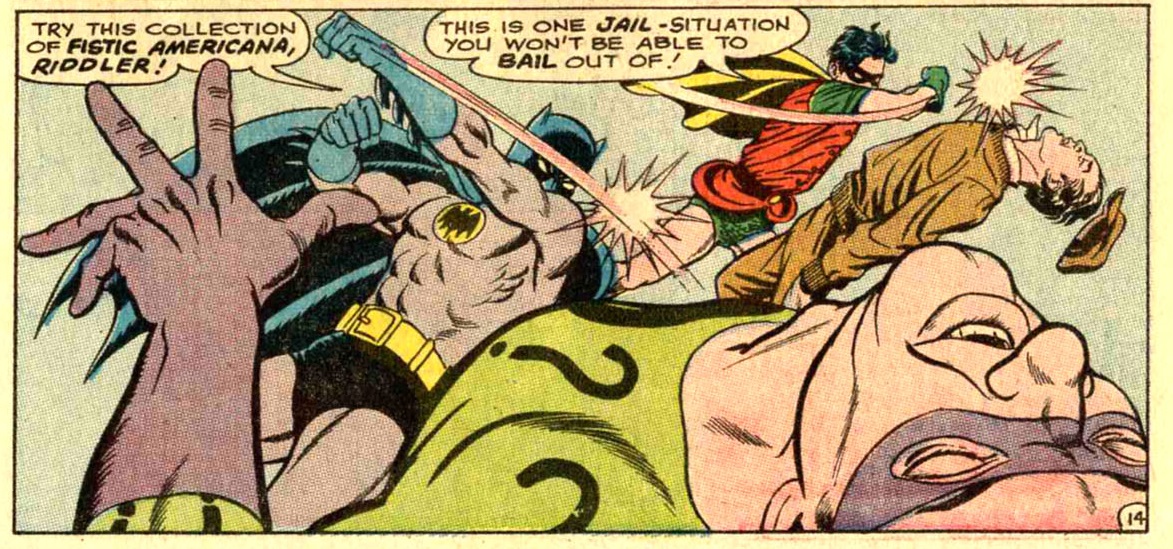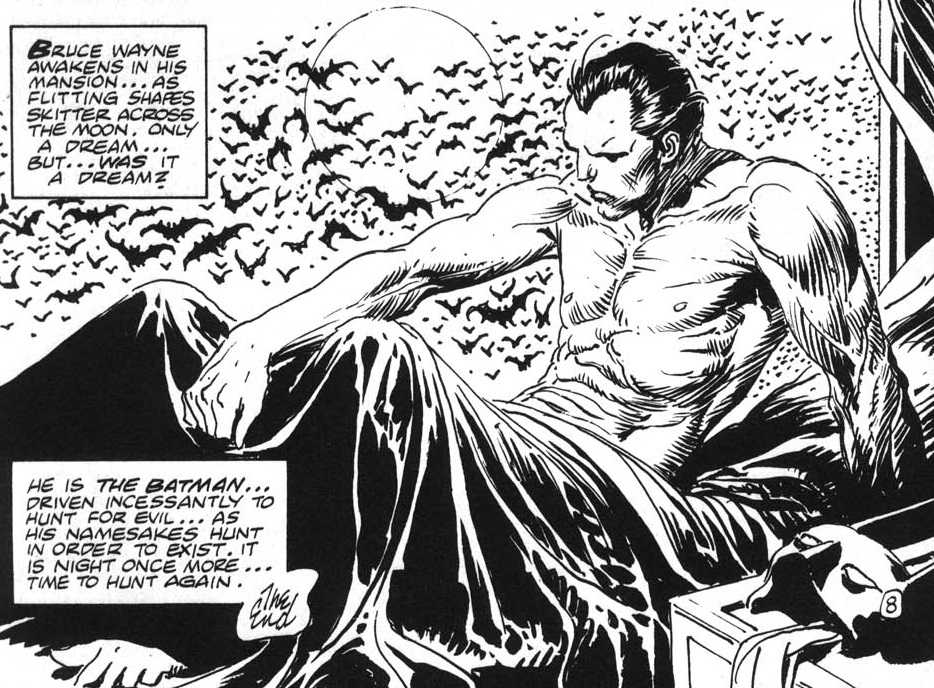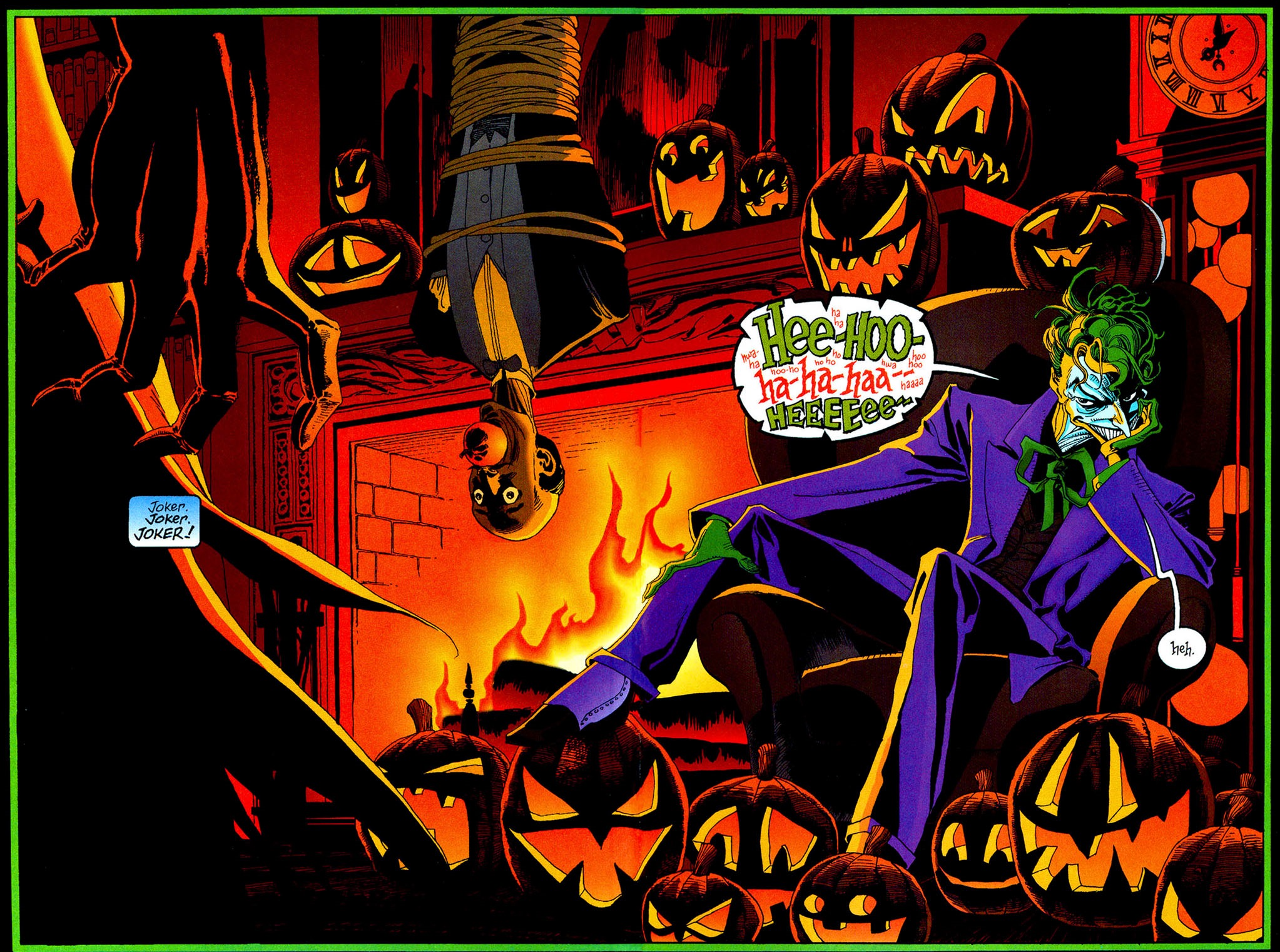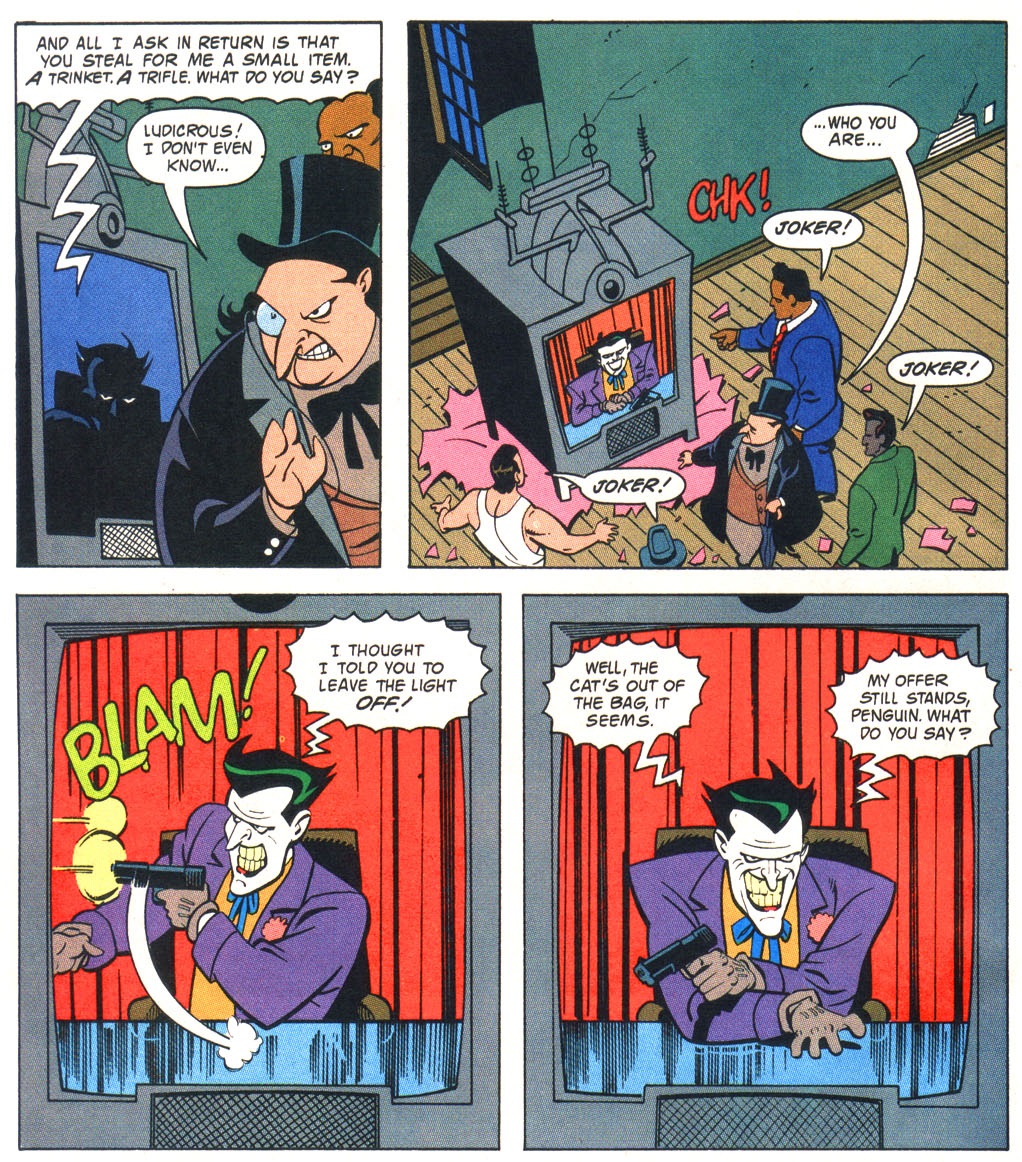Among the countless Batman books out there – old and new, classic or disposable – there is a whole subsection that strikes me as an ideal gateway for those who have heard of this Bruce Wayne fella but are still wondering what all the fuss is about. I’m talking about books that, rather than focus on one story or story-arc, collect a whole set of self-contained comics unburdened by complicated continuity, thus giving you plenty of bang for the buck.
These collections are great if you like your Dark Knight in digest form, with accessible one-and-done tales. They often include short stories in which the Caped Crusader acts as a supporting player in someone else’s journey as well as more straightforward adventures in which Batman’s awesomeness is not just the premise but the whole point. Anthologies can also allow you to sample the versatility of this character and his world in order to find out which version you prefer, since the Dark Knight has historically starred in various types of comics, from gritty crime yarns to superhero fantasy, from campy comedy to globetrotting epics, from grounded mysteries to crazy action romps in which the hero overcomes larger-than-life challenges (because Batman, motherfucker!).
That said, as it happens with all kinds of Batman publications, there is so much to choose from that you are at least as likely to find something utterly lame as to find something genuinely cool. With this in mind, I would recommend starting with one of the following collections:
BATMAN BLACK AND WHITE: VOLUME 1 (1997)
Collecting twenty Batman short stories – with barely a stinker in the bunch – this first volume of the Batman Black and White anthology series is mandatory reading for anyone who is into the psychological, film noir-influenced side of the Dark Knight. I’ve mentioned before that this series seems to bring out the best in all creators involved, so imagine what you can get when that applies to the most awesome artists and writers in the medium, like Ted McKeever, Bruce Timm, Archie Goodwin, and Walt Simonson, among many others.
As the title suggests, all stories are illustrated in moody black & white, which still leaves room for a wide range of art styles, from Matt Wagner’s deco pointillism in ‘Heist’ to Brian Bolland’s eerie photorealism in ‘An Innocent Guy,’ from Teddy Kristiansen’s childlike scratchy lines in ‘A slaying song tonight’ to Kevin Nowlan’s elaborate gothic designs in ‘Monsters in the Closet.’ What’s more, while many entries revolve around hardboiled crime fiction – including a contribution by Chuck Dixon, a master of the genre – there’s also a quirky tale about a vigilante who punishes petty acts (like jumping ahead in line or talking during a movie), a melancholic meditation on street gangs, and a funny bit about Batman and the Joker rehearsing their lines while complaining about the script.
THE GREATEST BATMAN STORIES EVER TOLD (1988)
There have been quite a few attempts at digging through the rich history of Batman comics and selecting the must-read ones – or at least selecting the most representative one-off tales – but 1988’s The Greatest Batman Stories Ever Told comes the closest to perfection (not to be confused with 2005’s Batman: The Greatest Stories Ever Told, which isn’t as wide-ranging).
Between the opening pages of ‘Batman versus the Vampire’ (a slice of horror pulp in which the Dark Knight follows his hypnotized fiancée to Hungary) and the bittersweet ending of ‘The Autobiography of Bruce Wayne’ (a coda to Earth-2 Batman, written with Alan Brennert’s skill for insightful characterization), there are literally dozens of stories full of colorful rogues, angry gorillas, and inventive escapes from deathtraps. Bona fide classics include the trippy ‘Robin Dies at Dawn’ (a key inspiration for Grant Morrison’s later Batman run), the whodunit ‘Ghost of the Killer Skies!’ (one of no less than three separate tales where Batman has to face villains armed with aircraft), the badass ‘Death Strikes at Midnight and Three’ (technically an illustrated prose piece), and the powerful ‘There Is No Hope in Crime Alley!’ Best of all, the book has all the installments of the wonderful Joe Chill trilogy – ‘The Origin of the Batman,’ ‘The First Batman,’ ‘To Kill a Legend’– an amazing example of myth-building across the decades.
Sure, not *all* of these comics have aged well, but even the ones that didn’t can provide interesting glimpses into the Caped Crusader’s publication history. The most obvious example is 1940’s ‘Hugo Strange and the Mutant Monsters,’ a crude riff on Frankenstein and King Kong that spotlights a time when Batman still lived in New York City and shot people with a machine gun attached to his Batplane.
HAUNTED KNIGHT (1996)
For a while, back in the nineties, it seemed like the wonder team of Jeph Loeb and Tim Sale could do no wrong. Before going on to do the acclaimed series The Long Halloween, they first left their mark on Batman with the trio of comics collected in Haunted Knight. These stories – three of the best Batman Halloween stories of all time – offer neat insights into Bruce Wayne’s insecurities early in his crime-fighting career. In ‘Fears,’ while going after the Scarecrow, Bruce wonders if he actually has a choice about being Batman. In ‘Madness,’ featuring the Mad Hatter, we learn that Batman uses Alice’s Adventures in Wonderland to cope with the loss of his mother. ‘Ghosts’ is a take on A Christmas Carol with Poison Ivy and the Joker as guiding spirits, showing Bruce that he shouldn’t limit his existence to the role of Dark Knight (fifteen years later, we got another great variation of A Christmas Carol in the form of Lee Bermejo’s gorgeous and shamelessly schmaltzy graphic novel Batman: Noël).
For all the strong character work done on Bruce Wayne (and Jim Gordon), the villains in Haunted Knight are reduced to psychotic abstractions, which gives the whole thing the feel of distorted memories. This is intensified by the dreamy artwork, with Tim Sale’s pencils, Gregory Wright’s colors, and Todd Klein’s lettering creating a stylized look that smoothly shifts from uncanny to exciting to touching to uplifting (including a beautiful, cameo-filled splash page of a costume party early on where you can tell Sale and the others are having a ball).
FEATURING TWO-FACE AND THE RIDDLER (1995)
 If there was one positive thing to come out of Joel Schumacher’s kitsch blockbuster Batman Forever, it was DC’s decision to release a collection of comics featuring the movie’s villains: Two-Face and the Riddler. These are two of the best creations in the Caped Crusader’s rogues’ gallery, not least because they come with neat built-in story designs. Two-Face, a district attorney-turned-criminal whose disfigurement (literal and figurative) split his personality in two and who now has to flip a coin in order to decide whether to act morally or not, invites tales with duality as a theme and symmetry as a motif. Likewise, the Riddler, a thief who sends the Dynamic Duo riddles hinting at his next heist in order to prove his intellectual superiority, is a charmingly simple story-making concept – if traditional Batman comics are all about the World’s Greatest Detective unraveling mysteries and ingeniously overcoming physical obstacles, the Riddler, with his compulsion to provide clues in the form of small puzzles that build up to a large trap, seems almost metafictionally doomed to act as a plot facilitator.
If there was one positive thing to come out of Joel Schumacher’s kitsch blockbuster Batman Forever, it was DC’s decision to release a collection of comics featuring the movie’s villains: Two-Face and the Riddler. These are two of the best creations in the Caped Crusader’s rogues’ gallery, not least because they come with neat built-in story designs. Two-Face, a district attorney-turned-criminal whose disfigurement (literal and figurative) split his personality in two and who now has to flip a coin in order to decide whether to act morally or not, invites tales with duality as a theme and symmetry as a motif. Likewise, the Riddler, a thief who sends the Dynamic Duo riddles hinting at his next heist in order to prove his intellectual superiority, is a charmingly simple story-making concept – if traditional Batman comics are all about the World’s Greatest Detective unraveling mysteries and ingeniously overcoming physical obstacles, the Riddler, with his compulsion to provide clues in the form of small puzzles that build up to a large trap, seems almost metafictionally doomed to act as a plot facilitator.
The book includes five imaginative tales from the forties and sixties. As you’d expect from comics written by Bill Finger and Gardner Fox, they are chock-full of slightly surreal sequences, like the robbery at a double-feature screening in which Two-Face replaces the reel of a Superman cartoon with a film of him threatening the audience, or an absurdly giant jigsaw puzzle that Batman puts together by assembling a team of cops in a stadium and radioing in instructions from a distance.
The modern era is represented by two exquisite comics. One is 1989’s Secret Origins Special #1, in which writer Neil Gaiman has an ageing Riddler nostalgically mourn the loss of whimsical capers in lieu of viciously violent crimes (this issue also revisits the origins of Penguin and Two-Face). The other is the brilliant ‘The Eye of the Beholder,’ in which the team of Andrew Helfer and Chris Sprouse give Two-Face’s origin a mature psychological treatment.
BATMAN ADVENTURES: VOLUME 1 (2014)
Whenever you see me complain about recent Batman comics or the current DC cinematic universe, this is the platonic ideal I am comparing them to. Batman Adventures is tight, sleek storytelling at its finest. Plus, it’s fun, it’s smart, it’s suited for all ages, and it actually features a likable Caped Crusader who doesn’t have to kill anyone to prove he’s cool! Borrowing the designs and spot-on, streamlined characterization from the amazing Animated Series, these comics deftly balance lighthearted antics and noirish aesthetics (including chapter titles that call back to old Hollywood, such as ‘Top of the World, Ma!,’ ‘A Star is Born!,’ and ‘Panic in the Streets’), with Batman battling retro-looking gangsters as well as his usual rogues’ gallery.
In 2014, DC started putting out collections of this series with 10 issues per volume. The first one, written with impressive pizzazz by Kelley Puckett and Martin Pasko, hits the ground running thanks to the super-stylish work of artists Ty Templeton, Brad Rader, Mike Parobeck, and Rick Burchett, as well as colorist Rick Taylor and letterer Tim Harkins. And amidst all the capers and mysteries and breakneck thrills, the book also delightfully takes a stab at less obvious genres like sports and slapstick comedy.




